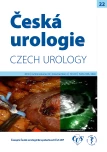Mondor’s penile disease – our results
Authors:
Jiří Ladman 1,2; Marek Koch 2; Radka Bulínová 2; Miloš Miniberger 3
Authors‘ workplace:
Urologické oddělení, Nemocnice České Budějovice, a. s., České Budějovice
1; Urologické oddělení, Nemocnice Písek, a. s., Písek
2; Radiodiagnostické oddělení, Nemocnice Písek, a. s., Písek
3
Published in:
Ces Urol 2018; 22(2): 122-125
Category:
Original Articles
Overview
Mondor‘s disease is a rare type of thrombophlebitis affecting the superficial veins, mainly with fibroproduction. It is characterized by a palpable rigid and usually painful stripe affecting the vein. It is more common in females, where it is located mainly on the breast, it is a rare disease in men, when it is mainly present on the penis area. The aetiology of the disease is based on Virchow’s triad (trauma of the vascular wall endothelium, blood stasis and hypercoagulable state).
Aim:
The aim of our work is to summerise our experience with diagnosis and treatment of patients in our out-patient department in the last three years.
Patients and methods:
Seven young men were included. Diagnosis was based on patient´s history, physical examination, and ultrasonography by using color Doppler scan. All men were referred to haematology for exlusion of coagulopathies. Results: The disease had a benign course and its treatment was mainly conservative and outpatient. In two cases there was a recurrence of thrombophlebitis.
Conclusion:
The lenght of therapy was based on a clinical finding with repeated checks, with both antibiotic prophylaxis and anticoagulants in our patients. Only four patients had haematological examinations, and an increased factor VIII activity was found in three. Treatment and reassessment of patients was impaired by poor compliance.
KEY WORDS
Mondor disease, thrombophlebitis, vena dorsalis penis superficialis, elevated activity of factor VIII
Sources
1. Nechanská B, Nedbálek A, Pabišta R. Trombóza povrchové dorzální žíly penisu (Penilní Mondorova choroba) – kazuistika. Ces Urol 2017; 21(2): 176–183.
2. Stolz J, Chocholatý M, Jarolím L. Penilní forma Mondorovy nemoci – kazuistika. In: Ces Urol Supplementum 2. Praha: Galén; 2011: 57.
3. Fejfar J, Janiš L, Štursa M. Tromboflebitida superficiální dorzální vény penisu. Urolog. praxi 2008; 9(4): 191–192.
4. Nazir SS, Khan M. Thrombosis of the dorsal vein of the penis (Mondor’s Disease): a case report and review of the literature. Indian Journal of Urology (online) 2010; 26(3): 431.
5. Karetová D. Trombóza povrchových žil – změna pohledu na rizika onemocnění a léčebný postup. Kapitoly z kardiologie 2013, 5: 130–134.
6. Dell‘Atti L. Role of ultrasonography with color– Doppler in diagnosis of penile Mondor’s disease. J Ultrasound. 2013; 17(3): 239–241.
7. Kartsaklis P, Konstantinidis C, Thomas C, Tsimara M, Andreadakis S, Gekas A. Penile Mondor’s disease: a case report. Cases J. 2008; 1(1): 411.
8. Shen HL, Liu SP, Wang SM, Tsay W, Hsieh. Elevated plasma factor VIII coagulant activity presenting with thrombophlebitis of the deep dorsal vein of the penis. Int J Urol. 2007; 14(7): 663–664.
9. Walsh J, Garvin D, Poimboeuf S. A common presentation to an uncommon disease. Penile Mondor’s disease: a case report and literature review. International Medical Case Reports Journal (online) 2014; 7: 155–157.
Labels
Paediatric urologist Nephrology UrologyArticle was published in
Czech Urology

2018 Issue 2
Most read in this issue
- Mondor’s penile disease – our results
- MRI ultrasound fusion biopsy in the diagnosis of prostate cancer
- Usage of indocyanine green in urological robotic surgery
- A rare case of eosinophilic funiculitis
